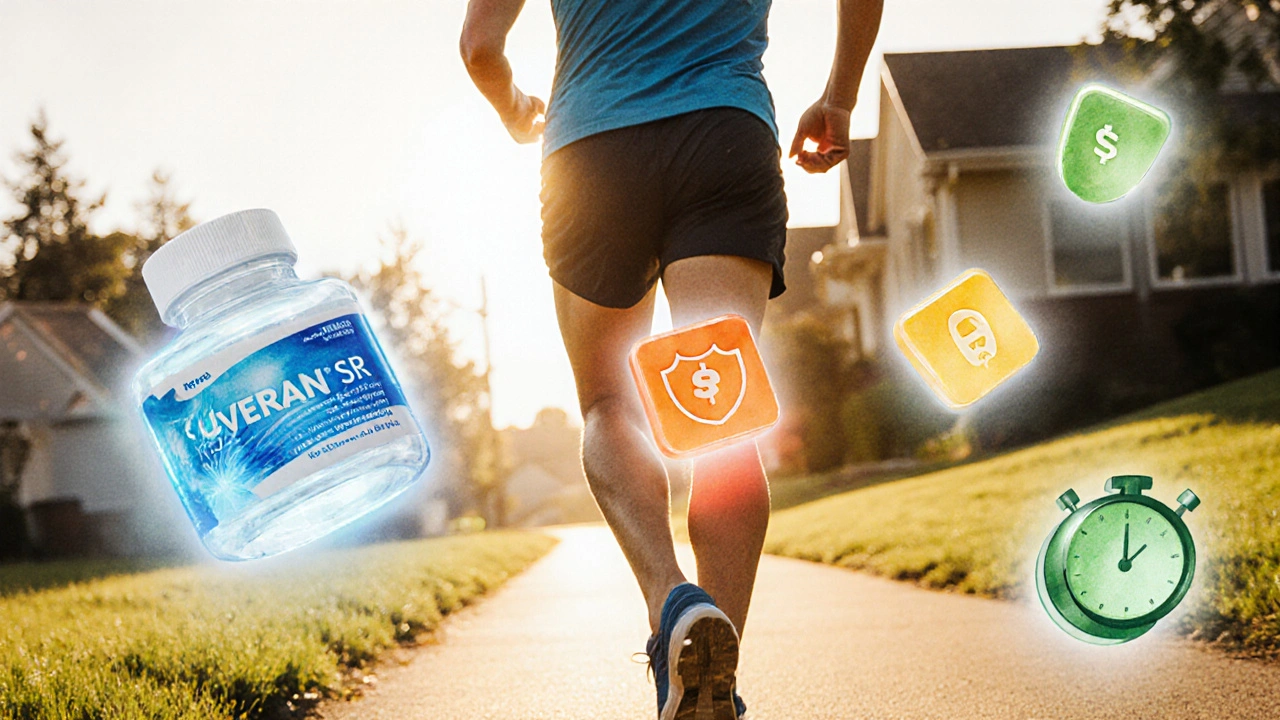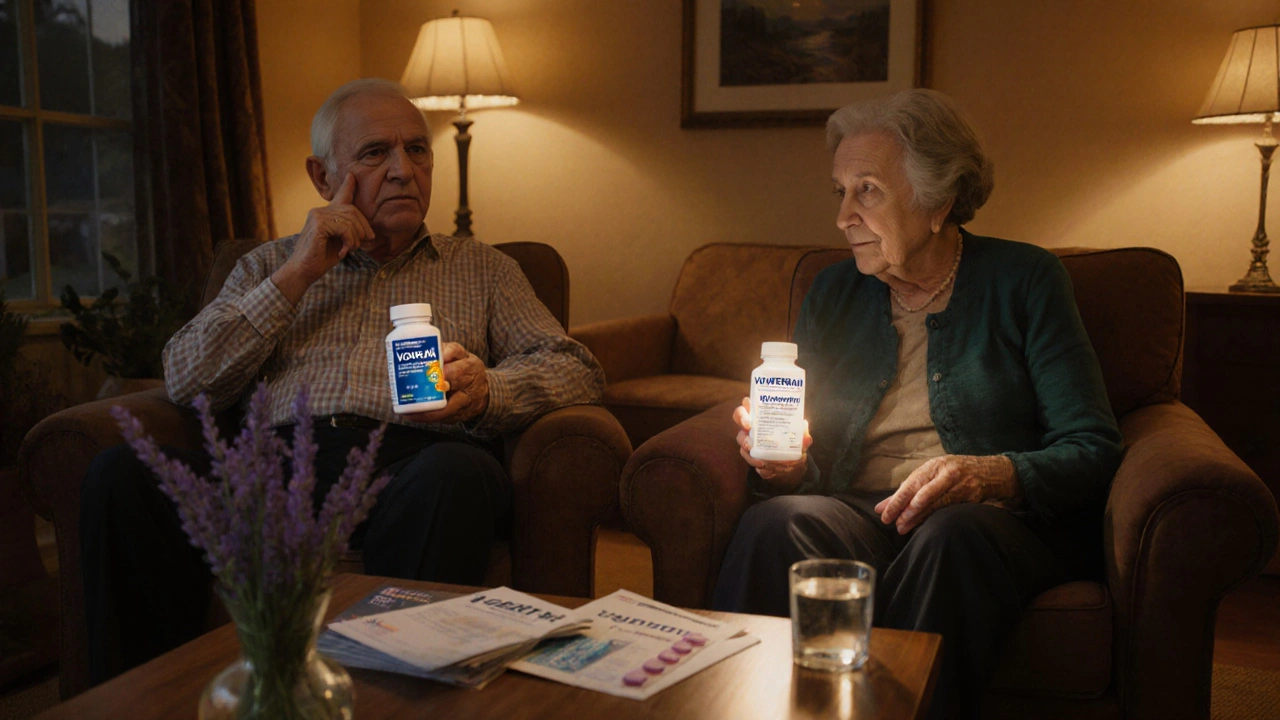 Sep, 29 2025
Sep, 29 2025
Pain Relief Comparison Tool
Select your condition and preferences to find the best pain reliever for you.
When it comes to managing moderate‑to‑severe pain, Voveran SR is a controlled‑release tablet that delivers diclofenac sodium, a non‑steroidal anti‑inflammatory drug (NSAID) designed to reduce inflammation and relieve pain.
TL;DR:
- Voveran SR gives steady diclofenac levels for up to 12hours.
- Ibuprofen and naproxen are cheaper OTC options but need multiple doses.
- Celecoxib targets COX‑2, lowering stomach risk but may raise heart risk.
- Paracetamol works for pain without inflammation, good for mild cases.
- Choose based on pain intensity, GI tolerance, heart health and cost.
How Voveran SR works
Diclofenac blocks the cyclooxygenase (COX) enzymes that create prostaglandins, the chemicals that cause swelling, fever and pain. The sustained‑release (SR) formulation spreads the drug’s effect over 12hours, so you usually only need two tablets a day. This steadier blood level can mean fewer peaks and troughs, which often translates to more consistent pain control.
Common alternatives at a glance
Ibuprofen an over‑the‑counter NSAID that blocks both COX‑1 and COX‑2 enzymes, providing pain relief in 30‑60minutes is widely used for headaches, muscle aches and mild arthritis. It’s cheap and easy to find, but the short half‑life means you’ll take it three to four times a day for lasting relief.
Naproxen a longer‑acting NSAID that also inhibits COX‑1 and COX‑2, staying active for up to 12hours offers a middle ground: fewer daily doses than ibuprofen, but a higher risk of stomach irritation for some people.
Celecoxib a COX‑2‑selective inhibitor that reduces inflammation while sparing the stomach lining is often chosen when gastrointestinal safety is a priority. The trade‑off is a higher price tag and a black‑box warning about possible cardiovascular events.
Paracetamol an analgesic and antipyretic that works centrally rather than by blocking prostaglandins provides pain relief without the anti‑inflammatory effect. It’s gentle on the gut and heart but won’t tackle swelling.
Aspirin an older NSAID that irreversibly inhibits COX‑1, useful for low‑dose cardiovascular protection and occasional pain can cause more stomach irritation than newer NSAIDs, especially at higher doses.
All of these drugs belong to the broader class of NSAIDs medications that reduce inflammation by inhibiting cyclooxygenase enzymes. Understanding where each fits helps you pick the right tool for the job.
Side‑effect profile comparison
Gastro‑intestinal (GI) irritation is the most common complaint with traditional NSAIDs because COX‑1 protects the stomach lining. Diclofenac, ibuprofen and naproxen share this risk, though diclofenac’s SR form may be a bit gentler. Celecoxib’s COX‑2 selectivity dramatically cuts stomach upset but shifts the worry toward the cardiovascular system. Paracetamol skips the GI issue altogether but can stress the liver if you exceed 4g per day.
Kidney function is another consideration; all NSAIDs can reduce renal blood flow, especially in older adults or people taking diuretics. If you have chronic kidney disease, the safest bet is often paracetamol or a low‑dose COX‑2 inhibitor under doctor supervision.

Cost and availability
Voveran SR requires a prescription in the UK and typically costs between £8‑£12 for a 28‑tablet pack. Ibuprofen and naproxen are available OTC for as little as £2‑£4 per pack, while celecoxib sits at around £15‑£20 for a month’s supply. Paracetamol is the cheapest, often under £1 for a full bottle.
Insurance coverage can tilt the balance: many NHS prescriptions for diclofenac are reimbursed for chronic arthritis, whereas OTC NSAIDs fall to the patient’s pocket.
Head‑to‑head attribute table
| Attribute | Voveran SR (Diclofenac) | Ibuprofen | Naproxen | Celecoxib |
|---|---|---|---|---|
| Typical dose | 50mg twice daily (SR) | 200‑400mg every 4‑6h | 250‑500mg twice daily | 100‑200mg once daily |
| Onset of relief | 30‑45min | 30‑60min | 45‑60min | 1‑2h |
| Duration of effect | Up to 12h | 4‑6h | 8‑12h | 24h |
| GI risk | Moderate | Moderate‑high | Moderate‑high | Low |
| Cardiovascular risk | Elevated (especially with high dose) | Low‑moderate | Low‑moderate | Higher (COX‑2 class) |
| OTC status (UK) | Prescription only | OTC | OTC (lower strength) | Prescription only |
| Typical price (28tablets) | £8‑£12 | £2‑£4 | £3‑£5 | £15‑£20 |
When to reach for Voveran SR
If you need round‑the‑clock pain control for conditions like osteoarthritis or chronic low‑back pain, the SR formulation can be a game‑changer. The twice‑daily schedule fits most routines and reduces the chance of missed doses. Patients who have already tried ibuprofen or naproxen without lasting relief often report better symptom control with diclofenac.
However, you should steer clear of Voveran SR if you have a history of stomach ulcers, uncontrolled hypertension, or recent heart surgery. In those cases, a COX‑2‑selective agent like celecoxib-or even a non‑NSAID option such as paracetamol-may be safer.
Tips for switching or combining therapies
- Talk to your GP before swapping prescription NSAIDs for OTC ones; dosing intervals differ.
- If you add a gastro‑protective agent (e.g., a proton‑pump inhibitor), take it at the same time as the NSAID to maximize protection.
- Monitor kidney function if you’re over 65 or take diuretics; a simple blood test every six months can catch problems early.
- Never exceed the maximum daily dose of any NSAID-doing so raises both GI and cardiovascular danger.
- When using multiple pain relievers, keep total acetaminophen (paracetamol) under 4g per day to avoid liver injury.

Frequently Asked Questions
Can I take Voveran SR with ibuprofen?
Combining two non‑selective NSAIDs raises the risk of stomach bleeding and kidney strain. If you need extra pain control, ask your doctor about adding a low‑dose opioid or a COX‑2‑selective drug instead.
Is Voveran SR safe during pregnancy?
Diclofenac is generally avoided in the third trimester because it can affect the fetal cardiovascular system. If you’re pregnant, discuss safer alternatives like paracetamol with your obstetrician.
How long can I stay on Voveran SR?
Most clinicians limit continuous diclofenac use to three months unless the benefits clearly outweigh the risks. Regular review appointments help decide whether to continue, taper, or switch.
What should I do if I experience stomach pain while on Voveran SR?
Stop the medication and contact your GP immediately. They may prescribe a proton‑pump inhibitor or suggest a different pain reliever.
Is there a generic version of Voveran SR?
Yes, the same dose of diclofenac sodium in a sustained‑release tablet is sold under several generic names. Prices can be lower, but you still need a prescription.
Dan McHugh
September 29, 2025 AT 16:27Diclofenac’s sustained release is handy when you want fewer pills a day. It does the job, but you’ll still watch the stomach warnings.
Sam Moss
September 30, 2025 AT 09:07I hear you on the convenience factor, especially for those juggling work and family. The steady plasma levels can smooth out the peaks and troughs that make pain feel like a roller‑coaster. Still, the GI trade‑off isn’t trivial; a lot of folks end up on proton‑pump inhibitors just to stay afloat. If you’re already on a PPI, the combination can be safer, but it adds another pill to the regimen. Ultimately, matching the drug to the person’s lifestyle and risk profile makes the biggest difference.
Suzy Stewart
October 1, 2025 AT 01:47Great points, Sam! 🎉 Diclofenac SR really shines when you need that 12‑hour blanket of relief, and the added optimism of fewer daily doses can lift morale. 🚀 Still, I’m all about pushing patients to consider gastro‑protective strategies early – the risk isn’t worth the gamble. Let’s keep the conversation sharp and remember that proactive monitoring beats reactive panic.
Traven West
October 1, 2025 AT 18:27Whoa, Suzy, tone‑down the drama. It’s just a drug, not a life‑changing revelation. Stick to facts.
Jonny Arruda
October 2, 2025 AT 11:07Honestly, the drama can be useful – it grabs attention, which is why people actually read the safety notes. I’m chilling here, just saying the risk‑vs‑benefit dance is the same for any NSAID, whether it’s SR or OTC.
Melissa Young
October 3, 2025 AT 03:47Diclofenac SR is a solid choice for chronic pain.
khajohnsak Mankit
October 3, 2025 AT 20:27From a philosophical angle, the sustained‑release mechanism mirrors the human desire for stability amidst the chaos of chronic discomfort. One could argue that the tablet becomes a silent partner in the daily meditation of pain management, offering a steady rhythm that soothes both body and mind.
Jayant Paliwal
October 4, 2025 AT 13:07Let us embark on a contemplative journey through the labyrinth of pharmacological wisdom, where each molecule whispers the ancient tale of human suffering and relief. The saga begins with the humble prostaglandin, a biochemical harbinger of inflammation, marching across cellular membranes to proclaim pain. Diclofenac, a valiant knight of the NSAID order, intervenes by breaching the cyclooxygenase citadel, thereby stalling the cascade of agony.
Yet, like any heroic figure, it bears a shadow – the specter of gastrointestinal jeopardy, a reminder that triumph always demands a price. The sustained‑release formulation, crafted with temporal elegance, spreads its influence like a sunrise over a restless sea, granting twelve hours of solace. This temporal grace reduces the frequency of dosing, diminishing the peaks of plasma concentration that often herald side‑effects.
Contrast this with ibuprofen, a swift but fleeting sentinel, whose brief tenure necessitates multiple daily summonses, each echoing a risk of renal strain. Naproxen, the elder statesman, offers a middle path, lingering longer yet still courting the stomach’s ire. Celecoxib, the selective COX‑2 artisan, spares the gastric lining but whispers warnings of cardiovascular turbulence.
In the grand tapestry of therapeutic choices, the physician becomes the weaver, selecting threads of efficacy, safety, cost, and patient preference. The art lies in balancing the needle’s point – too sharp, and tissue suffers; too blunt, and relief wanes. Thus, the discourse on Voveran SR is not merely about a pill, but about the philosophy of living with pain, the ethics of risk, and the economics of health.
Kamal ALGhafri
October 5, 2025 AT 05:47From a know‑it‑all perspective, the hierarchy of NSAIDs is crystal clear. Diclofenac sits in the middle tier – more potent than ibuprofen, less selective than celecoxib. Its risk profile is predictable: moderate GI irritation, elevated cardiovascular caution at high doses. The key is monitoring renal function, especially in the elderly. If you’re already on a diuretic, the combination can tip the balance toward acute kidney injury. Always pair it with a gastro‑protective agent if the patient has a history of ulcers. A generic version exists, shaving off a few pounds from the prescription cost, yet the therapeutic essence remains unchanged. This is why prescribers often default to Voveran SR for chronic musculoskeletal pain when the budget permits. The bottom line: efficacy, safety, cost – weigh them wisely.
Gulam Ahmed Khan
October 5, 2025 AT 22:27Spot on, Kamal! 🙌 The balance you mentioned is exactly what I tell my patients. 👍 If they’re vigilant about dosing and combine with a PPI, the GI risk drops dramatically. Just keep an eye on blood pressure and heart health.
John and Maria Cristina Varano
October 6, 2025 AT 15:07i think voveran sr is overrated and most people could just use ibuprofen its cheaper and works fine for most pain im not convinced the extra cost is worthwhile.
Amy Collins
October 7, 2025 AT 07:47Honestly, the cost‑benefit analysis tilts toward OTC NSAIDs for the majority. If you’re not on a strict regimen, ibuprofen or naproxen give you the bang for the buck without the prescription hassle.
amanda luize
October 8, 2025 AT 00:27Hold on – the pharma giants have engineered a narrative that pushes prescription NSAIDs like Voveran SR as superior, all to inflate profits. Look at the subtle marketing in the fine print; it’s a classic push‑drug tactic. The data on long‑term safety is murky at best, and every new “study” is riddled with conflicts of interest. Stay skeptical.
Abhishek Vora
October 8, 2025 AT 17:07It’s a dramatic saga, isn’t it? The tale of a humble tablet battling the forces of inflammation, heart risk, and corporate intrigue. In the end, the hero is the informed patient, armed with knowledge and a dash of caution. 🎭